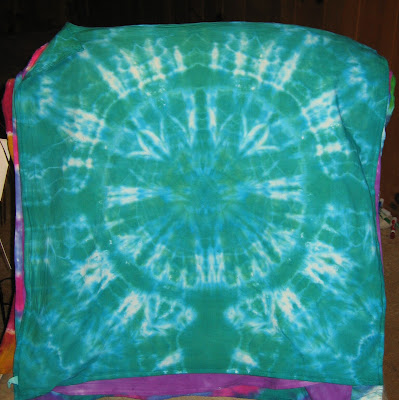I could probably retrofit these to Japanese motifs, but that's not how I found them.
Instead, I got bored and just started folding and tying.

The towel above was folded in half and then tied in a complex flower petal kind of fold. The top motif was on the outside when the towel was dyed, and displays the intended flower pattern. The bottom motif, surprisingly, delightfully, has lost both the upright and cross pieces almost completely and is a grand and glorious purple flaming X.
This is why untying shibori is like Christmas. Every piece turns out differently from how you imagined it. Wonderfully, gloriously different. (And sometimes, particularly when you're just starting out, disastrously "Wow, I just wasted my money on clothes I wouldn't be caught dead in" different.)
But then, I've seen normal and I don't like it, and my kids' mom dresses them funny.
A fairly decent chevron-y fold with pretty good pleat action.
I have no idea what I was thinking when I tied the above one. No clue. It was almost 2 years ago and I was at a party. The fold looked kind of like it wanted to be itajime, but it's definitely struck off on its own.
Not only that, but it uses two colors that I have decided I don't like but have therefore not quite managed to use up. The maroon bleeds well but is ugly with everything. The mustard is so ugly that even mixing it 3:1 with delicious golden brown could not dim its ugliness.
A candidate for overdyeing with something like turquoise.
Chocolate-covered cherries anyone?
Seriously, I like that fold. A lot. If I can figure out how I did it, I'll do it again.
And yes, I did go a little overboard on the hot pink. I like its bleed action.
I could make a wicked Scottish flag with that fold. Or the crossbones for a skull-and-.































